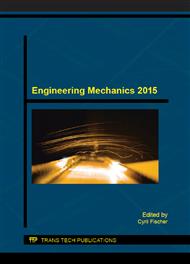p.709
p.717
p.725
p.733
p.741
p.747
p.753
p.761
p.767
Reliability of Approach Slabs and Modelling of Transition Zones of Bridges
Abstract:
The approach slab is the structural member of transition zones, which compensates a different settlement of bridge abutment and a road embankment. The main reason of different settlement is the consolidation of soil under the slab and the abutment. The geometry of approach slab, its length and the thickness is defined on the basis of differential settlement of embankment and the abutment. The static behaviour of slab is defined as a slab on elastic soil. The reinforced concrete slab is supported with the line rigid support on the one edge, and the rest of slab area interacts with the soil. The civil engineers design the reinforcement in those slabs based on the simplified structural scheme, without considering the elastic area support. This scheme is the simple supported slab on the both ends. The paper is dealing with the comparing of different structural models of the reinforced concrete approach slabs. The complex models of transition zones with the brick elements of the soil and the interaction with the reinforced concrete slab with the soil embankment are compared with the simplified models used by civil engineers. The analysis was performed on the transition zone of highway bridge from Slovakia based on its geometry and the subsoil consistence. In the parametric study was compared 8 soil stiffness’s on 10 structural models.
Info:
Periodical:
Pages:
741-746
Citation:
Online since:
January 2016
Authors:
Keywords:
Price:
Сopyright:
© 2016 Trans Tech Publications Ltd. All Rights Reserved
Share:
Citation:


